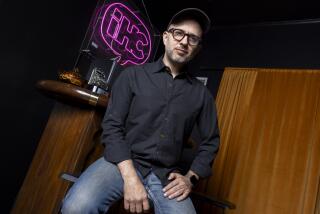Car Crash Kills 5 Near Site of Huge Rave Party : Accident: Vehicle plunges 1,200 feet from Angeles Crest Highway. Victims had tickets to the all-night event.
- Share via
Five young people who had apparently attended an all-night rave party at a San Gabriel Mountains ski resort died Sunday morning, just as the gathering was breaking up, when their car plunged off a steep embankment on Angeles Crest Highway.
Rescuers rappelled a 1,200-foot ravine lined with pine trees and massive boulders to reach the bodies of four females and a male, thought to be in their teens or 20s, then used body baskets attached to a helicopter to lift out the remains.
U.S. Forest Service spokeswoman Gail Wright said the victims were carrying tickets to the rave party, which drew an estimated 5,000 techno music fans to Snowcrest Snowpark, formerly known as the Kratka Ridge ski resort, about 35 miles northeast of La Canada Flintridge in Angeles National Forest.
The young people, whose names and ages were not released, were heading east toward Wrightwood when their car left the road at an S-curve shortly after 7:30 a.m., authorities said.
A motorist who saw the plunge told the California Highway Patrol that the car had not been speeding, nor had the driver slammed on the brakes.
Four bodies were ejected from the vehicle, a Toyota Camry. The fifth was found in the wreckage, wedged against towering pine trees at the bottom of the steep ravine. All were pronounced dead at the scene.
Some who attended the rave said drug use--particularly of Ecstasy and LSD--was widespread. Paramedics said they were called to assist several overdose victims during the party, which was held under a U.S. Forest Service permit. Authorities would not speculate on whether drug use was a factor in the fatal crash.
Angeles National Forest has been the site of several raves--parties that offer what aficionados describe as the mesmerizing effects of techno music, flashing strobes and an aura of peace, love and hugs that some dancers supplement with drugs.
An Internet site promoting this one suggested that it was to be one of the season’s major events, with tickets going for $30 apiece.
Billed as “the ultimate summertime adventure” by the event’s promoter, identified in a flier both as B3 Cande Productions and as JujuBeats, the rave was advertised to young people in California, Arizona and Nevada. The promoter did not return a message to his pager Sunday night.
Young people who attended the party, which featured disc jockeys and electronic music with a heavy beat, described it as a good one.
“This party rocked from start to finish,” one attendee said on an Internet message board.
John Steely, the ski resort owner who rented his premises to the rave promoter, said he was told that six young people were evacuated from the party by air because of drug overdoses or other medical emergencies.
Steely, who said his resort has hosted about half a dozen raves, estimated that the promoter for this one spent about $100,000 on the event--money used in part to fly in celebrated disc jockeys from out of town. The promoter also paid for 80 security guards and provided valet parking, Steely said.
The promoter’s permit did not allow partygoers to bring any food or drink, and Steely said partygoers were searched on entry.
Hot dogs, snacks, candy and nonalcoholic beverages were sold at the event.
The highway outside the ski resort was lined with parked cars for 10 miles during the event and littered with trash and promotional fliers afterward.
The Los Angeles area has been host to raves--enormous dance parties in warehouses or open areas--for more than 10 years.
The concept of raves is largely “built upon sensory overload,” according to a Web site designed for a communications course at UC San Diego.
The Web site goes on to describe the sense of community that rave participants proclaim. “A popular term for this phenomenon used throughout rave culture is PLUR: Peace, Love, Unity and Respect,” it says.
On his way home Sunday afternoon, Bill Stewart from San Diego stopped to play some rave music for a reporter on his truck CD. Bass-centered dance music. It throbbed.
“Hear that?” Stewart said. “It’s nothing like that when you’re actually there. It’s so intense, your whole body feels it.”
Stewart and some friends--two carloads and truckloads of revelers from San Diego--said most hard-core ravers go to a party every weekend. They have driven as far as Palm Springs to attend.
They said they usually don’t know where they are going until they get to a check site, advertised on fliers and over the Internet by promoters. At the check site, they pick up a map to the event.
The practice originated as a way to heighten excitement and keep the authorities from raiding what often are illegal events.
One of the San Diegans, who would identify himself only as Warner S., said he misses “the old days” when rave-goers had to go to four or five check sites before finding out the location of an event.
“Finding the thing was part of the fun,” he said.
One of his companions, Kelly A., said she goes mainly for the music.
“The atmosphere is so different from a club, which is more like a meat market,” she said. “Here, nobody hits on you, everybody hugs everybody all the time.”
Times staff writers Joe Mozingo, Carla Rivera and Hugo Martin contributed to this report.
More to Read
Sign up for Essential California
The most important California stories and recommendations in your inbox every morning.
You may occasionally receive promotional content from the Los Angeles Times.










